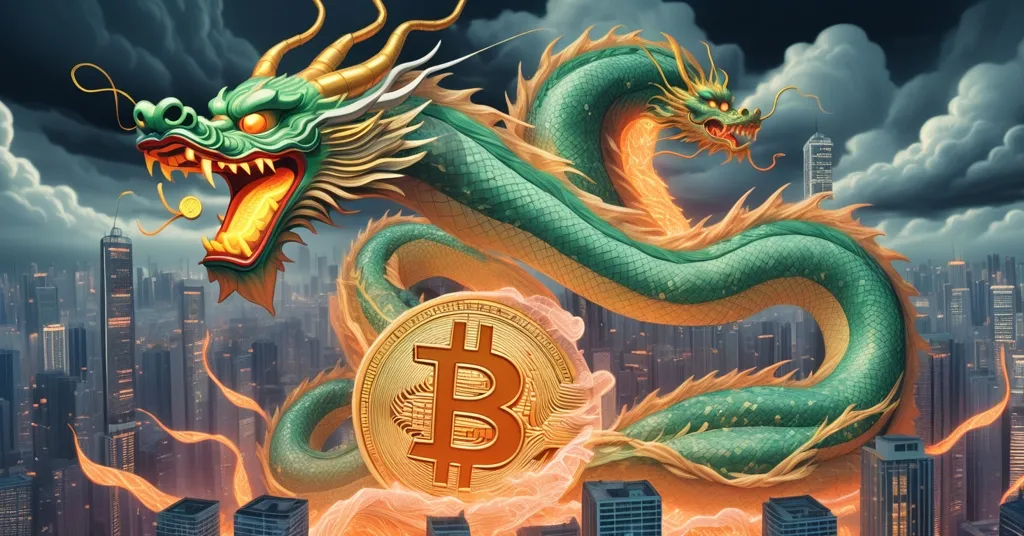China’s Yuan Fix and $84B Liquidity Surge: Bitcoin Markets on Edge

China’s Yuan Fix and Liquidity Surge: A Bitcoin and Global Market Shake-Up
China has fired a bold shot across the bow of global finance, setting the yuan at its strongest level since January and flooding its markets with a staggering 600 billion yuan ($84 billion) in liquidity. As the U.S. dollar weakens and speculative fever grips China’s tech and housing sectors, these moves could ripple through to Bitcoin and the crypto space, even with Beijing’s iron grip on decentralized assets.
- Yuan Power Play: PBOC sets yuan at 7.1161 per dollar, strongest since January.
- Cash Flood: $84 billion injected to calm bond markets and fuel equity surges.
- Market Mania: Tech and housing stocks soar, but bubble risks loom large.
The People’s Bank of China (PBOC) has pegged the yuan’s daily reference rate at 7.1161 per dollar, a significant shift from Friday’s 7.1321 and the first time it’s dipped below 7.12 since November. For those unfamiliar, this reference rate adjustment is a tightly controlled benchmark set by the PBOC each day, dictating a narrow band within which the yuan can trade. A tweak like this—seemingly small—can alter the price of Chinese exports on the global stage, directly impacting their economy. This strengthening comes as the U.S. Dollar Spot Index dropped 0.8% after Federal Reserve Chairman Jerome Powell’s Jackson Hole speech hinted at rate cuts due to labor market strains. A weaker dollar often makes Chinese goods pricier abroad, so the PBOC’s move looks like a calculated bid to keep trade competitive while signaling stability. Yet, while the onshore yuan—traded within China’s borders—hit a high of 7.1593 (its strongest since late July), it slipped against a broader basket of currencies, showing this isn’t a clear-cut victory lap.
Alongside this currency maneuver, Beijing dropped a liquidity bomb, injecting 600 billion yuan into the financial system via Medium-Term Lending Facility (MLF) loans and reverse repos—the biggest monthly cash dump since January. Let’s break this down: MLF loans are medium-term funds handed to banks to keep credit flowing, while reverse repos are short-term cash boosts where the central bank buys securities with a promise to sell them back later. The aim? Soothe a stressed bond market, where overnight repo rates fell to 1.35% (down 7 basis points—a tiny percentage shift, where 100 basis points equals 1%), and keep funding conditions loose as retail investors ditch savings for stocks. The impact was instant: 30-year government bond futures spiked 0.7%, their sharpest daily gain since April. But let’s cut the crap—pouring this much fuel into an already overheated market risks blowing up speculative bubbles, and China’s got plenty of those brewing, as seen in discussions about the economic impact of such liquidity injections.
Tech Sector on Fire: Echoes of Crypto Hype
China’s tech sector is a blazing inferno of speculation right now. The Star 50 Index, a hardware-focused benchmark, rocketed 5.8% in a single day, boasting a 20% gain over the past month. Chip-related exchange-traded funds (ETFs) are the darlings of this frenzy, with the CPIC SSE STAR Chip Design Thematic ETF trading at a 6.2% premium compared to its usual 0.1%. Other funds, like the Penghua SSE STAR Chip ETF and China Universal SSE Science and Tech Innovation Board 50 ETF, are riding the same wave, driven by hype over domestic semiconductor leaps—think DeepSeek’s new AI model—and Beijing’s relentless drive for tech self-reliance. With U.S. export controls choking access to advanced chips, China’s hell-bent on building its own tech fortress, a strategy supercharged by years of trade spats.
But here’s the ugly truth: this smells like a bubble waiting to burst. Market watchers are screaming about overheating, with stock prices divorced from fundamentals. Remind you of anything? It’s 2017 ICO mania all over again, when every half-baked crypto project was a “moonshot” until the rug got pulled. China’s tech ETFs are trading at laughable premiums, and if history’s any guide, the crash could be brutal, with growing bubble risks threatening global markets. For us in the crypto crowd, it’s a stark reminder that speculative excess isn’t unique to Bitcoin or altcoins—it’s a human flaw, amplified by easy money and FOMO.
Housing Rally: Stability or Another Mirage?
Switching gears, China’s housing sector—long a pain point—is getting a sugar rush. Property stocks surged, with China Vanke Co. hitting a six-month high and dragging the sector index up 3%. In Hong Kong trading, Vanke soared 16%, Sunac China Holdings Ltd. jumped 13%, and Longfor Group Holdings Ltd. followed close behind. What’s behind this? Whispers of more policy support from Beijing, which has been desperate to prop up a real estate market that drives a massive chunk of China’s GDP. Past regulatory crackdowns, like the “three red lines” policy to curb developer debt, left the sector bruised, with defaults piling up. Now, stimulus is the name of the game.
But don’t get too cozy. Pumping more cash into housing without tackling the mountain of structural debt is like slapping a Band-Aid on a gaping wound. If this rally fizzles—or worse, if defaults spike again—global risk sentiment could take a hit, and that’s bad news for everything from stocks to crypto. China’s economy is a juggernaut, and when it stumbles, we all feel the tremors.
Bitcoin and Crypto: Hedge or Hostage to Fiat Games?
So, what does this financial circus mean for Bitcoin and the broader crypto landscape? Let’s connect the dots. When central banks like the PBOC flood markets with cash, it often devalues fiat currencies—think inflation on steroids. Historically, Bitcoin has shined in these moments as a hedge against fiat devaluation, a “hard money” alternative with a fixed supply of 21 million coins, immune to printing presses. Look at 2020: global stimulus after COVID sent Bitcoin soaring over 300%, per CoinGecko data, as fiat lost purchasing power. China’s $84 billion injection and a weaker U.S. dollar could spark similar risk-on sentiment, nudging investors toward decentralized assets.
But hold the hype. China’s domestic crypto bans—mining and trading outlawed since 2021—mean local demand won’t directly juice Bitcoin’s price. Over 50% of BTC’s hashrate fled to places like the U.S. and Kazakhstan post-crackdown, according to the Cambridge Bitcoin Electricity Consumption Index, though offshore Chinese capital still sneaks into crypto markets. More importantly, if China’s tech or housing bubbles pop, a risk-off wave could slam Bitcoin and altcoins, just as we saw in March 2020 when BTC briefly tanked alongside equities, dropping nearly 40% in days. Sure, Bitcoin’s a decentralized beast, but it’s not immune to global panic, and questions remain about how China’s yuan policies impact Bitcoin.
Playing Devil’s Advocate: Is Bitcoin Really a Safe Haven?
Let’s poke holes in our own optimism. Bitcoin’s often hailed as a safe haven during fiat chaos, but correlation data tells a murkier story. During sharp downturns, like the 2022 bear market or the 2020 crash, BTC has moved in lockstep with risk assets like stocks, per CoinMetrics analysis. If China’s speculative bubbles burst, dragging global markets into a tailspin, don’t be shocked if Bitcoin takes a 20-30% hit in the short term. Long-term, its fundamentals—scarcity, decentralization—hold strong, but short-term volatility can burn even the staunchest HODLers, especially when considering the broader context of China’s strongest yuan fix since January.
Another thorn: China’s liquidity moves might prop up traditional markets for now, reducing the urgent flight to alternatives like crypto. Why rush to Bitcoin if fiat-fueled equities keep climbing? It’s a fair question, and one we can’t ignore while preaching disruption. Still, every central bank stunt is a reminder of why we’re here—building a system where no single player, be it Beijing or Washington, calls the shots. For deeper insight into the mechanics of China’s currency system, check out this overview on the yuan’s exchange rate policies.
Key Takeaways and Questions for Crypto Enthusiasts
- Why did China strengthen the yuan to 7.1161 per dollar?
The PBOC adjusted the rate after a 0.8% drop in the U.S. dollar, triggered by Federal Reserve hints at rate cuts, to maintain trade competitiveness and signal market stability. - What’s behind China’s $84 billion liquidity injection?
Aimed at easing bond market stress and supporting equity surges, this cash flood through MLF loans and reverse repos is the largest since January, though it risks inflating bubbles. - Could China’s financial moves boost Bitcoin demand?
Potentially—central bank easing often drives investors to Bitcoin as a hedge against fiat devaluation, though China’s crypto bans limit direct local impact. - Are China’s tech gains a bubble warning for crypto markets?
Damn right—sky-high ETF premiums echo past crypto manias like 2017’s ICO craze, a loud alarm that speculation can crash hard in any asset class. - How does China’s centralized tech push clash with blockchain?
Beijing’s state-driven innovation in AI and chips is the antithesis of decentralization, yet it might spur global demand for privacy-focused crypto as a counterweight. - Should crypto investors fear a Chinese market collapse?
Yes—if tech or housing sectors implode, global risk-off sentiment could hammer Bitcoin and altcoins, as past downturns like March 2020 proved with sharp drops. - Is Bitcoin a true safe haven amid fiat volatility?
Only partially—while its fixed supply offers long-term protection, short-term price swings often correlate with broader market panic, challenging the ‘safe haven’ label. - What can crypto enthusiasts do in response to China’s moves?
Stay sharp, diversify into decentralized assets, monitor global risk trends, and back projects resisting centralized control, whether through Bitcoin or niche altcoins.
China’s latest financial chess moves—strengthening the yuan and unleashing liquidity—are a loud reminder of how tangled global markets remain, even for those of us betting on decentralized escapes like Bitcoin. While we cheer for a future free from fiat’s endless manipulations, we’ve got to keep our eyes wide open. Central bank plays, speculative bubbles, and policy gambits can still rattle the crypto space, for better or worse. As Beijing tightens its grip on currency and tech, are we accelerating a decentralized future fast enough to outrun their centralized playbook? That’s the real question worth wrestling with.



